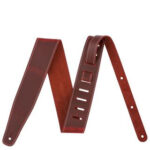Learning to tune your guitar is one of the very first steps in your musical journey. An out-of-tune guitar simply won’t sound right, no matter how well you try to play. This guide will help you understand What Notes Are The Strings On A Guitar, how to tune your instrument using various methods, and how to keep it sounding its best for longer. Consistent practice is key to mastering the guitar, and playing in tune makes that practice enjoyable and rewarding.
Understanding the Basics of Guitar Tuning
Guitar tuning is all about adjusting the tension of the strings to reach the correct pitches. This adjustment is done using the tuning pegs located on the guitar’s headstock. Turning these pegs either tightens or loosens the strings, changing the pitch. Tightening a string increases the pitch (making it sharper), while loosening it lowers the pitch (making it flatter).
How Often Should You Tune Your Guitar?
Ideally, you should tune your guitar every single time you pick it up to play. Guitars are sensitive instruments and can easily fall out of tune even when not being played due to changes in temperature or humidity. Playing itself, especially techniques like string bending or extended playing sessions, will also cause a guitar to drift out of tune.
It’s a good habit to check your tuning frequently while you are playing. If chords start to sound muddy or off-key, even when you’re sure you’re playing the correct finger positions, it’s a clear sign that your guitar needs retuning.
 Video demonstrating how to tune a guitar
Video demonstrating how to tune a guitar
Methods for Tuning Your Guitar
Modern technology has made tuning incredibly accessible and straightforward, thanks to electronic tuners. However, learning to tune by ear using a reference note is also a valuable skill for any guitarist.
Tuning with a Chromatic or Pitch Tuner
Clip-on electronic tuners have revolutionized guitar tuning. These compact devices attach directly to your guitar’s headstock and detect string vibrations to determine pitch. They clearly indicate whether a string is flat (too low), sharp (too high), or perfectly in tune. They are highly effective for both acoustic and electric guitars, offering an inexpensive and precise tuning solution. Many beginner guitar amplifiers even come equipped with built-in tuners for added convenience.
Tuning Your Guitar Without a Tuner
If you find yourself without a dedicated tuner, don’t worry! There are still effective ways to tune your guitar.
Mobile tuner apps are readily available for smartphones and tablets, many of which are free. These apps utilize your device’s microphone to analyze the pitch of your guitar strings and provide visual feedback as you adjust the tuning pegs. This method offers a convenient and often accurate way to tune your guitar.
Alternatively, you can use a reference pitch from another instrument, such as a piano or a reliably tuned guitar. This method involves tuning one of your guitar strings to match the reference pitch by ear.
Tuning by ear requires a bit more practice and a developed sense of pitch. You’ll need to listen carefully to the reference pitch, play the corresponding note on your guitar, and compare the two. Adjust your guitar string until it matches the reference pitch. Once you have one string correctly tuned, you can then tune the remaining strings relative to each other by fretting notes and matching them to the open strings.
Discovering Guitar String Names & Notes: EADgbe
A standard guitar has six strings. When looking at your guitar in playing position, the strings are numbered from 1 to 6, with the 1st string being the thinnest string at the bottom and the 6th string being the thickest string at the top.
The standard guitar string notes, from thickest (6th string) to thinnest (1st string), are E, A, D, G, B, and E. This is known as standard tuning.
 Diagram of guitar string notes in standard tuning EADgbe
Diagram of guitar string notes in standard tuning EADgbe
To help remember the guitar string names, many guitarists use mnemonic devices, such as:
- Eddie Ate Dynamite, Good Bye Eddie
- Eat Apple Donuts Good Bye Emily
- Every Average Dude Gets Better Eventually
The thickest string is the 6th string, also referred to as the low E string, and the thinnest string is the 1st string, or high E string.
 Mnemonic phrases to remember guitar string names EADGBe: 'Eddie Ate Dynamite, Good Bye Eddie'
Mnemonic phrases to remember guitar string names EADGBe: 'Eddie Ate Dynamite, Good Bye Eddie'
While standard tuning (EADgbe) is the most common, exploring alternate guitar tunings can open up new sonic possibilities and are worth investigating as you progress.
Step-by-Step Guide to Tuning Each Guitar String
Let’s walk through how to tune each string in standard tuning, assuming you are tuning the guitar to itself (without an external reference pitch initially, but using the relationship between strings). We will start with the thickest string, the low E string (6th string).
Tuning Your Low E String (6th String)
If you have a reference pitch available (from a tuner, piano, or another instrument), begin by tuning your low E string to that reference. If you don’t have a reference, you can use the 7th fret of the A string (5th string) as your E note to tune the low E string to.
Tuning the 6th String (Low E)
Tune the low E string until it matches your reference E note. Adjust the tuning peg, tightening to raise the pitch if the string is flat (too low) or loosening to lower the pitch if the string is sharp (too high).
Tuning the 5th String (A String)
Next, to tune the A string, fret the low E string (6th string) at the 5th fret. This fretted note is an A. Play this note and then play your open A string. Adjust the tuning peg of the A string until the open A string pitch matches the pitch of the 5th fret of the E string.
Tuning the 4th String (D String)
To tune the D string, fret the A string (5th string) at the 5th fret. This fretted note is a D. Play this note and then play your open D string. Adjust the tuning peg of the D string until the open D string pitch matches the pitch of the 5th fret of the A string.
Tuning the 3rd String (G String)
To tune the G string, fret the D string (4th string) at the 5th fret. This fretted note is a G. Play this note and then play your open G string. Adjust the tuning peg of the G string until the open G string pitch matches the pitch of the 5th fret of the D string.
Tuning the 2nd String (B String)
The tuning pattern changes slightly for the B string. To tune the B string, fret the G string (3rd string) at the 4th fret (not the 5th fret as with previous strings). This fretted note is a B. Play this note and then play your open B string. Adjust the tuning peg of the B string until the open B string pitch matches the pitch of the 4th fret of the G string.
Tuning the 1st String (High E String)
Finally, to tune the high E string, fret the B string (2nd string) at the 5th fret. This fretted note is a high E. Play this note and then play your open high E string. Adjust the tuning peg of the high E string until the open high E string pitch matches the pitch of the 5th fret of the B string.
Once you become comfortable with tuning and understanding what notes are the strings on a guitar, you’ll be ready to explore more advanced techniques like reading guitar tabs and learning your favorite songs!
Tips for Keeping Your Guitar in Tune Longer
After you’ve tuned your guitar, there are several simple steps you can take to help it stay in tune for longer periods:
- Replace Your Strings Regularly: Old guitar strings lose their elasticity and intonation, making it difficult for them to hold tune. When your strings start to sound dull or require frequent tuning adjustments, it’s time to replace them with a fresh set.
- Stretch New Strings: New guitar strings need to be stretched out to stabilize their pitch. After installing new strings, gently stretch them by hand or by playing for a short period, retuning as needed. Be careful not to pull too forcefully, which could cause them to break.
- Proper Guitar Care and Storage: Protect your guitar from drastic changes in temperature and humidity. Extreme conditions can cause the wood to expand or contract, affecting tuning stability. When you’re not playing, wipe down the strings with a clean cloth and store your guitar in its case or gig bag.
By following these tuning methods and maintenance tips, you’ll ensure your guitar sounds its best, making your practice sessions more productive and enjoyable.
Are you considering buying a new guitar? Check out our Guitar Buying Guide!

